Here’s my guide to visiting the glamorous Opera Garnier in Paris. The opera house is a must visit attraction in the 9th arrondissement.
A creation of Charles Garnier, it was part of Napoleon’s great makeover of Paris. It’s highly decorative, a mix of Beaux-Arts symmetry and Baroque and Renaissance elements.
Visiting Paris’ Opera Garnier is a dual-purpose immersive experience.
You can experience the incredibly opulent palace space, designed by Charles Garnier. And you can re-live the Gothic potboiler, The Phantom of the Opera, from Gaston Leroux and Andrew Lloyd Webber fame.
What could be better? An over the top Paris opera house for an over the top murder-y opera villain.
Until recently, I hadn’t been inside for a long time. I saw the famous Chagall ceiling when I was young.
Thereafter, I satisfied myself with admiring the impressive facade of what may be the world’s most famous opera house, as I strolled past it in the 9th arrondissement.
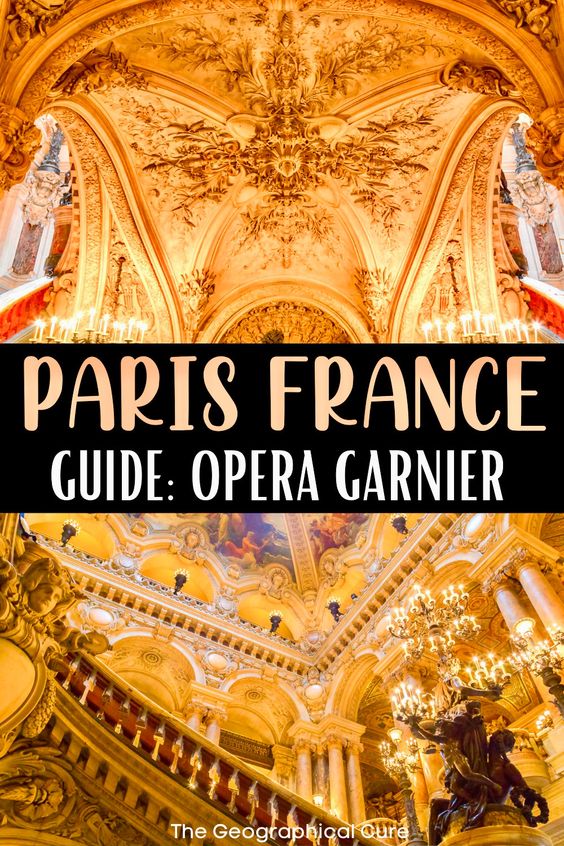
But the last time I was in Paris, I was assailed by murky recollections. And by the Phantom’s plaintive theme song playing “there inside my mind.”
I hadn’t planned on going in. But I did. It’s almost as if I was involuntarily ventriloquized by Andrew Lloyd Weber.
If you don’t want to head to Versailles and suffer through the awful lines, come here instead.
The Opera Garnier’s just as sumptuous, maybe more so, than Versailles and hence a great alternative. Truly, the opera is one of Paris’ most unsung hidden gems, a gaudy jewel box treasure.
Open the jewel box and look in, don’t just stroll by.
History of the Opera Garnier
The Opera Garnier, also known as the Palais Garnier, first sprang from the brain of Napoleon III.
It wasn’t a calculated choice. While attending the Opera of Rue Le Peletier, Napoleon barely escaped a bomb in an assassination attempt.
Right then and there, Napoleon resolved to build a new opera house that he could safely attend. One that had a private entrance just for him. Besides, Paris needed a glamorous new theater.
In 1860, Napoleon held an international competition for the design of the new Paris Opera. 171 proposals were submitted anonymously.
An unknown architect won, the 34 year old Charles Garnier, putting the seasoned Parisian architects to shame. His project was number #38, named “I aspire to much, I expect little.”
Garnier was so inexperienced that he didn’t even have his own office. He had to build one on the opera site. And he didn’t like the site overly much. It was smushed together and enclosed between four roads in the shape of a diamond.
Garnier repeatedly asked for a different venue. But the answer was always no. Haussman’s grand boulevards and Paris’ urban renewal were the first priority. Roads were more important than opera.
In 1861, Garnier began construction. His masterpiece took 15 years to finish. The opera is wholly Garnier’s creation, from start to finish. He designed everything.
Garnier also selected and guided the work of collaborating artists, many of whom were prestigious grand prize winners. In total, there were 15 principal artists, 75 sculptors, and myriad artisans who slaved away on the Opera Garnier.
It didn’t all go smoothly. In 1962, the builders discovered a lake underneath the site.
They created a stone cistern — an artificial lake — for the water and underground tunnels, as a work around. Even today, the cistern halts the rising water, though water still needs to be pumped out. The tank’s also used for Paris firefighters to practice nighttime swimming.
Construction of the Paris Opera was also controversial. Almost operatic, if you will. Everyone felt entitled to weigh in on the splashy new place.
Garnier’s plan was mocked as a labyrinth, a turkish bath, and wedding cake. Even Empress Eugenie asked Garnier what style he was aiming for. His terse response was that it was “in the Napoleon style, Madame.” Louis XIV style was passé.
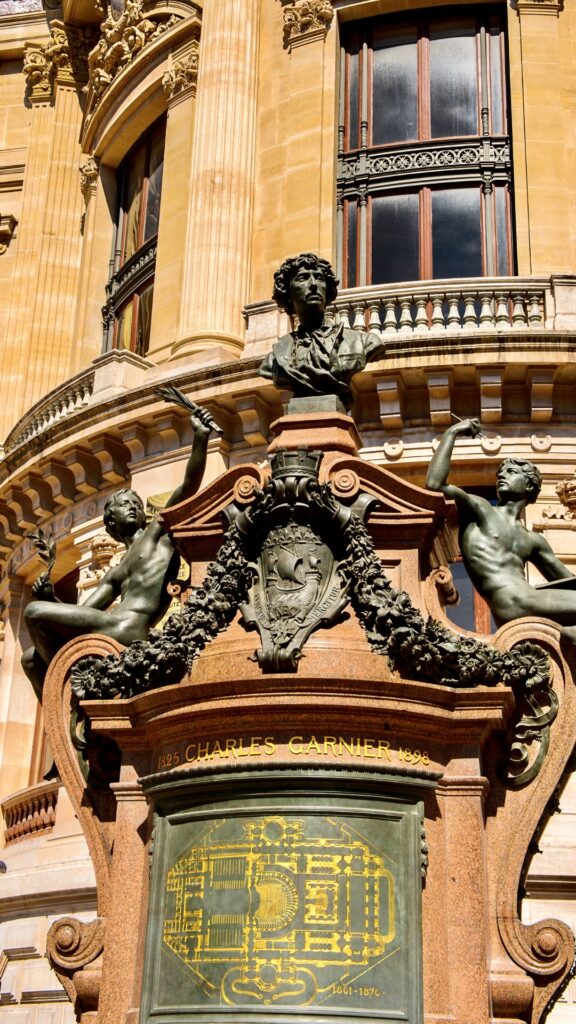
During construction, the opera facade was kept under wraps, to build tension. When the opera was finally inaugurated in 1875, the public saw the showy facade for the first time.
And they were stunned.
Tickets & Tours
The Opera Garnier is a popular attraction that you should book ahead. Click here to book a skip the line ticket. Click here to book a 2 hour guided tour.
Guide To The Opera Garnier: What To See
Here’s what you’ll see on a visit to the Opera Garnier.
Exterior Facade
The exterior is sometimes compared to a wedding cake. You can sort of see why.
It’s built in a rather bombastic Beaux-Artes style with eclectic Neo-Baroque elements. Between the grand columns are bronze busts of great composers. The two gilded figures crowning the facade on the left and right are Harmony and Poetry.
At the very top, there’s a statue of a shining Apollo holding up a lyre. He seems intent on proclaiming that the opera house is THE place for arts.
One the eastern side is the Emperor’s Pavilion, the only non-symmetrical part of the building. This was the entrance for Napoleon and wealthy season ticket holders. It’s now closed.
The most famous sculptural group on the facade is The Dance by Jean-Baptiste Carpeaux.
When it was unveiled in 1869, it caused an immediate furor because of its “obscene” nude figures. An anonymous vandal even threw black ink on the sculpture.
Carpeaux steadfastly refused to sculpt a substitute. But during the fall of the Second Empire, critics were distracted.
The sculpture was forgotten and never replaced. Now, there’s a replica on the opera facade and the original is in the Musée d’Orsay.
READ: Guide To the Masterpieces of the Musee d’Orsay
Paris Opera Interior
You enter on the left side and are greeted by a bust of Garnier.
The interior was designed in four segments: the entrance, the auditorium, the stage, and the administrative offices. As you proceed through, it’s almost a crescendo, with each room more magnificent than the next.
The acoustics were outstanding, and the stage one of Europe’s largest.
The highlights are the Grand Staircase, the Grand Foyer, and the Chagall Ceiling. You begin on the ground level and are greeted by costumes. The Opera Garnier makes all their own costumes, an impressive feat itself.
1. Grand Staircase, aka the Catwalk
Then you walk up the jaw dropping Grand Staircase. It’s made entirely of marble, and surrounded with arches, hidden nooks, statues, and gold — gold everywhere.
In the 19th century, the haughty Grand Staircase was a gossipy soap opera, the place to see and be seen.
Garnier aptly said that “The opera is the staircase.” The scandalous stairway revealed all — who was together, who was having affairs, who was favored, who was scorned.
The staircase is made of white marble from Italy, with balusters of antique red and green marble. The staircase is flanked by 36 large columns, and divides into two staircases that direct opera goers to their respective seats.
The ceiling has fresco by Isidore Pils, painted in 1869-74, that depicts the Triumph of Apollo. At the top of the staircases are large torchieres.
2. The Grand Foyer, a Mini Versailles Hall of Mirrors
The 18 foot high Grand Foyer is astonishing. It’s decidedly reminiscent of the Hall of Mirrors at Versailles.
This was the place where aristocrats strolled after they were done “acting” on the Grand Staircase or during intermission.
The room is all gold and glitter. At the top, is another impressive ceiling fresco, this one by Paul Baudry, which shows the history of music.
The foyer’s key decorative motif is the lyre. The Grand Foyer was renovated to perfection in 2004.
At each end of the grand foyer lie two salons. The Salon du Soleil (Sun Salon) has a golden sun burst and mirrored walls. The Salon de la Lune (Moon Salon) boasts a night sky adorned with silver moon rays and stars.
The sun room was supposed to represent fire and be the smoking room. The moon room was supposed to represent ice, for a cool sorbet.
But the decorator reversed the schemes to Garnier’s dismay. Opera goers were forced to traipse through the “ice room” to smoke a cigar and the “sun room” to nibble a sorbet.
3. Chagall Ceiling: A Surrealistic Gift to Paris
The Marc Chagall ceiling isn’t original. It was commissioned in 1964 and placed over the existing academic painting by Jules-Eugene Lenepveu, The Muses and the Hours of the Day and Night.
But it’s so much better. It’s the perfect backdrop for the Garnier-designed 7 ton bronze and crystal chandelier.
Legend holds that General de Gaulle and Andre Malraux, minister of culture, were attending an opera with a set and costumes designed by Chagall. The minister glanced at the ceiling and frowned in tedium. On the spot, he asked Chagall to design a new ceiling.
Chagall was a “modern” artist back then. His supernatural style work drew from the artistic movements of Surrealism, Fauvism, and Cubism.
The proposed ceiling was controversial. Some people don’t like anything new. Some thought it was garish and would clash with the opera’s Second Empire decor.
To keep the peace and as a concession to critics, Chagall proposed that Lenepveu’s work be preserved and Chagall’s be placed on a removable canvas stretched over it.
The mural took Chagall a year to complete. It consists of 12 canvas panels and a round central panel covering 240 square meters.
Chagall was 77 at the time and it was an act of love. He donated it to the opera house gratis. The mural has his trademark features — luminous prismatic colors, dreamy details, and poetic lyricism.
If you look closely, you’ll see that the ceiling is an homage to music. It features 14 composers from different musical periods, musical instruments, and Paris’ signature buildings.
Malraux is even hidden behind a window. Chagall’s ceiling helped make the opera more fashionable again.
4. Auditorium and Stage
Red is the color of glamor. And that’s what you’ll find in the opera auditorium.
If you want to actually visit the auditorium, you have to go on a guided tour. On the self-guided audio tour, you can only peek through a window and can’t properly see the Chagall ceiling.
The auditorium is very ornate, decorated in red velvet, marble, and gold leaf. Because you can never have enough gold leaf in an opera house. If you’re thinking that it’s just all too much, remember that opera itself a florid overwrought affair.
The stage is a classic horseshoe shape. The curtain is actually made of canvas, but contrived to appear like draping velvet. The stage featured many luminaries, including opera star Maris Callas and dancer Rudolf Nureyev.
The auditorium seats almost 2,000. While gorgeous, the seats don’t look terribly comfy. They were made in another era, where comfort didn’t dictate nearly everything.
The most expensive seats are the boudoir-like boxes, though they have a slightly obstructed view of the stage.
The point, of course, was to be seen by others, not to have the most ideal view of the performance. Or, to draw the velvet curtains for a tryst. The opera’s a romantic place, after all.
Phantom of the Opera: Inspired by the Opera Garnier
By today’s politically correct standards, with its clunky plot, Phantom of the Opera may seem a bit dated or patriarchal. But I can’t resist a lush high Gothic romance, even if the titular hero is a bit murdery. It’s escapism, as its author Gaston Leroux, a true crime writer and opera critic, no doubt intended.
Yet, the practical side of me always wonders where the Phantom got a horse and does he have a humidifier.
In any event, for purposes of this article, I want to explain how historical events at the Opera Garnier inspired Leroux’s 1910 potboiler. His fantasy novel is an ingenious blending of fact and fiction, with the Paris Opera as a star character.
The novel stars Erik as the phantom, a disfigured composer who wears a mask to cover his face. He takes up residence in the underground lake beneath the theater.
Erik becomes obsessed with a young soprano, Christine Daaé. He becomes her “angel of music,” giving her complimentary singing lessons.
The phantom rigs a chandelier to fall on the audience as a distraction, killing people. He then kidnaps Christine, taking her by gondola to his watery underground lair full of secret tunnels. He regales her with the title song Phantom of the Opera and Music of the Night.
Christine’s star rises, and a handsome suitor enters the picture. A jealous Phantom is furious and begins terrorizing the opera house. I won’t spoil the ending if you haven’t read the novel or seen the musical.
But many elements of Leroux’s novel, which is set in an opera house, come directly from the Paris Opera. The Phantom’s underground lake-lair is real, as I mentioned above. Though today it’s brightly lit, so not as eerily gloomy. And there are actually tunnels, just as Leroux wrote.
The Paris Opera chandelier is also featured in Leroux’s novel. In 1896, a counterweight fell from the real chandelier, killing a woman in the audience. In Phantom, Leroux also uses a falling chandelier as a major plot point, a dramatic scene (described above) of kidnapping and senseless murder.
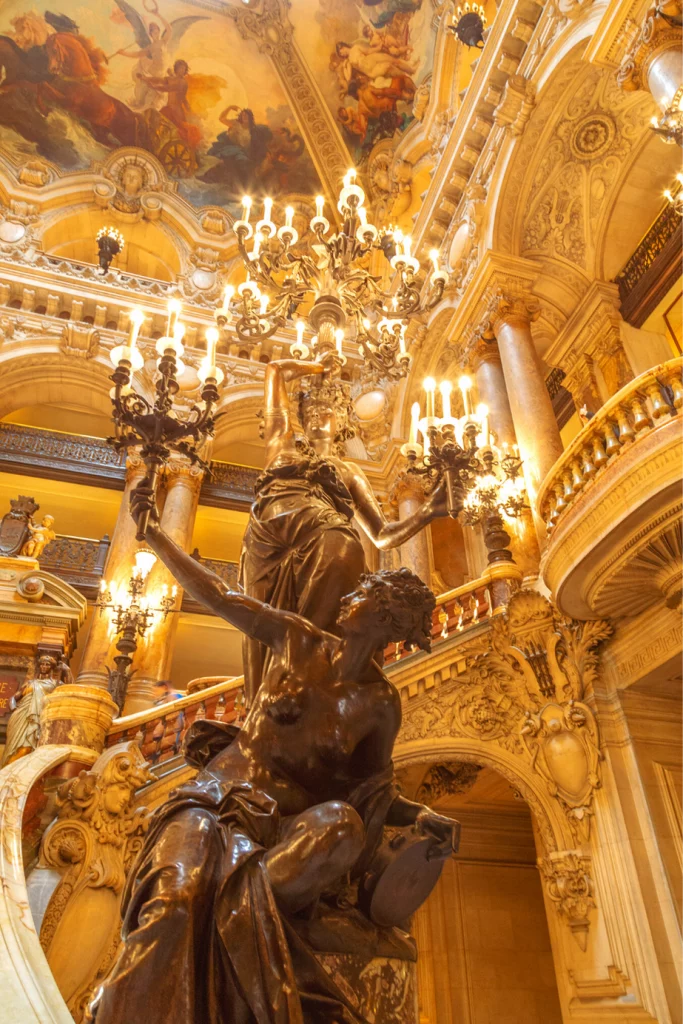
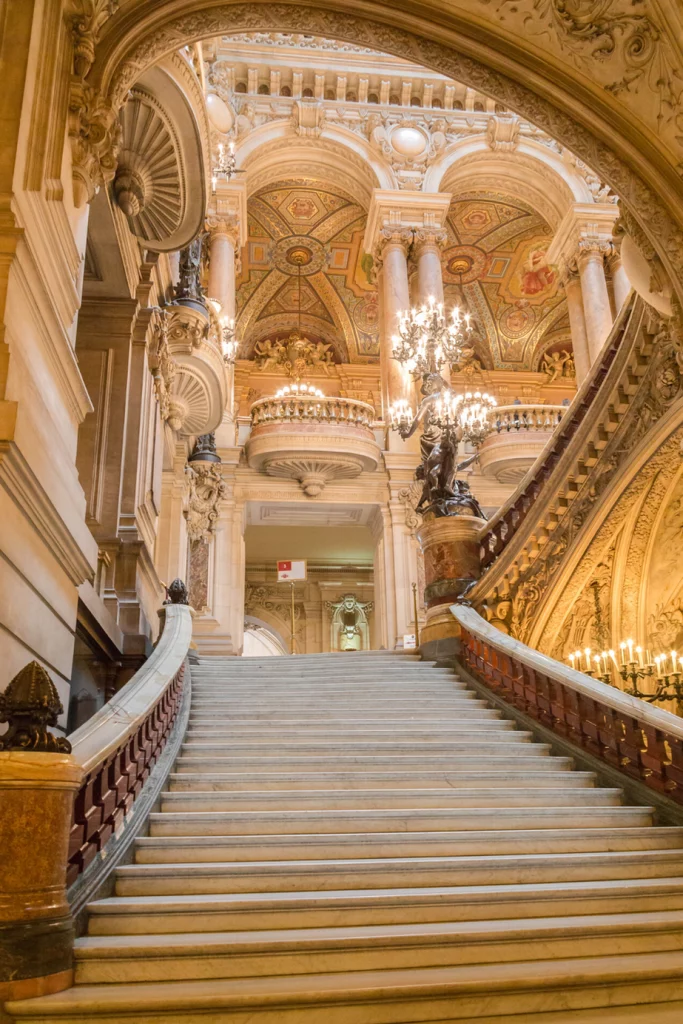
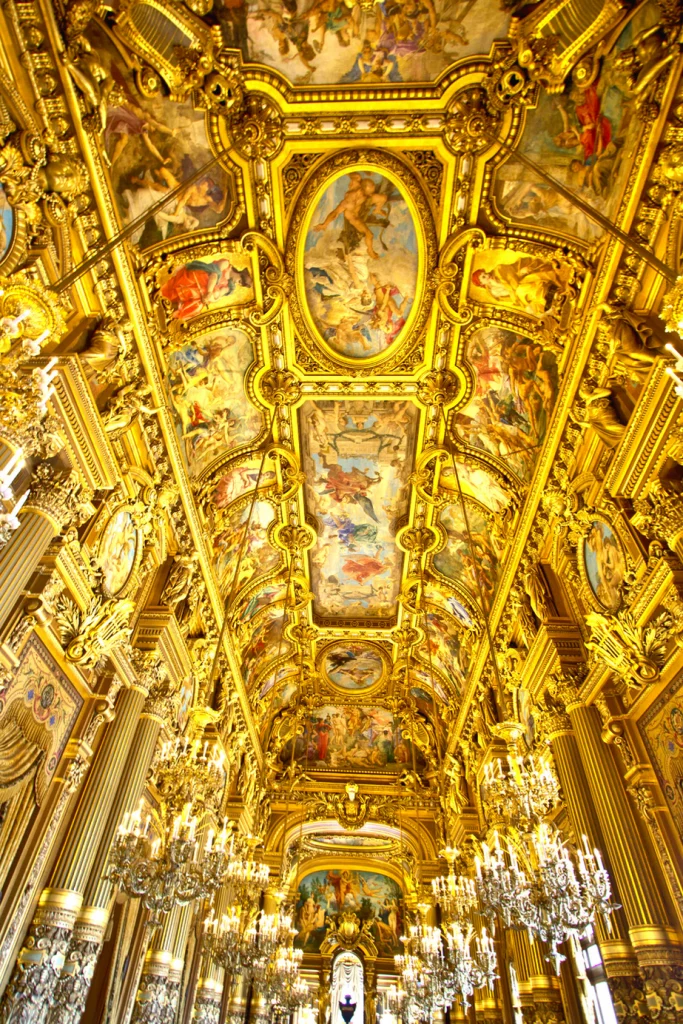
When Leroux wrote his novel, people also really thought that a pesky ghost was haunting the Paris Opera, just like the phantom haunts the opera in the novel and musical.
Paris Opera performers hung a lucky horseshoe by the stage to ward off evil spirits. Some claimed to hear ghostly whispers from Box #5, even when it was vacant.
Although the Christine-Phantom romance is fantasy, the characters of Erik and Christine may be based on actual people.
The grand masked ball they attend was set on the Paris Opera’s Grand Staircase. The Phantom appears on the staircase dressed as Red Death, carrying a copy of his new opera. His opera is then performed on a stage much like the Paris Opera stage.
Tips For Attending a Performance at the Opera Garnier
The Opera Garnier still functions as a world class performance venue. It’s the home of the Paris Ballet. So usually ballet is on the menu, but there are also concerts and operas.
You can check the schedule of performances here.
Just click on the calendar to see what’s playing that month. Click on Garnier, not Bastille. The new Opera Bastille utterly lacks the Garnier’s old world ambiance anyway.
It’s easiest to reserve online. You need to register on the website to book a ticket. Choose your seats. And voila!
Attire is mostly business-y or business casual, which makes sense because people are going to the opera house after work. You won’t need a fancy ballgown, unless you’re going to a special evening gala.
Like most US theaters, there’s a bar inside that sells champagne and snacks before the show and during intermission.
Arrive early to admire the gorgeous building and take photos on the iconic marble stairway. If the performance isn’t in English, there will be subtitles.
But don’t let the subtitles distract you from gazing, in adoration, at the sublime Chagall ceiling. If you’re not close enough, head to the orchestra section during intermission to take in the colorful centerpiece.
Don’t miss the glorious Opera Garnier. It’s an unmissable Paris site and one of the best things to do in the 9th arrondissement.
Swathed in gold, you can strain your ears to hear echos of the Phantom of the Opera. You won’t be kidnapped or killed. But you can visit the haunts that inspired the novel and bask in Garnier’s grandiose creation.
Practical Guide & Tips for Visiting the Opera Garnier:
Address: 8 Rue de Scribe, Place de l’Opera 75009 Paris
Hours: 10:00 am to 4:30 pm, Guide tours in English are at 11:00 am and 2:30 pm
Entry fee: 14 euros for a self guided tour. Not included in Paris Museum Pass.
Metro: Line 3, 7, or 8 to Opera
Pro tips: The nearest car park is Place Vendome. Access to the auditorium may be closed for technical reasons or performance rehearsals.
Virtual Tour: If you can’t get to Paris, you can explore the Opera Garnier virtually on Google Arts & Culture.
I hope you’ve enjoyed my guide to the Opera Garnier. You may enjoy these other travel guides and resources for Paris:
- 5 Day Itinerary for Paris
- 3 Day Itinerary for Paris
- 2 Day Itinerary for Paris
- One Day In Paris Itineraries
- Tips for Planning a Trip to Paris
- Tourist Traps To Avoid In Paris
- Top Attractions in Montmartre
- Top Attractions in the Latin Quarter
- Top Attractions in the Marais
- Best Museums In Paris
- Hidden Gems in Paris
- Secret day trips from Paris
If you like to visit the Opera Garnier in Paris, pin it for later.

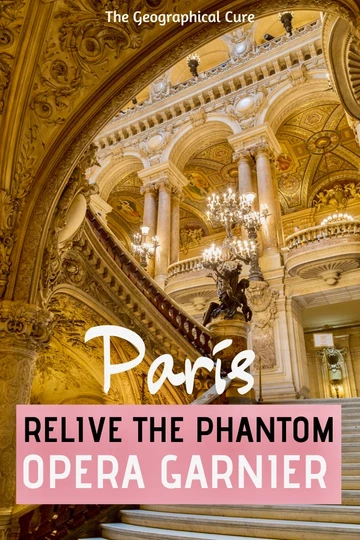
Very interesting many thanks for this, I would love to visit